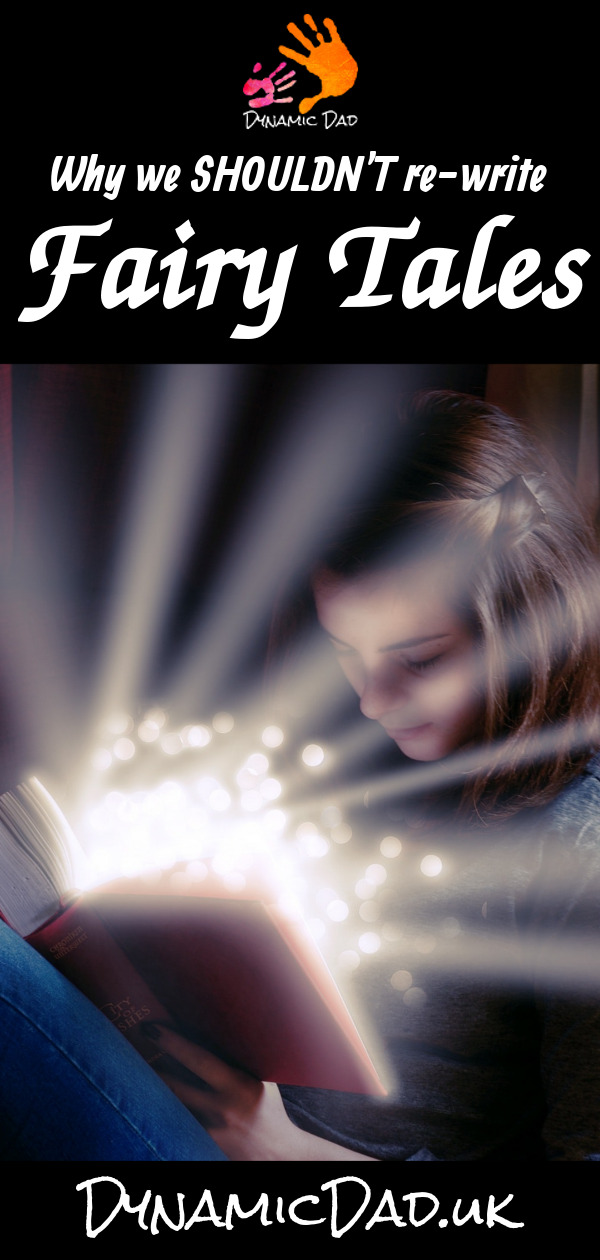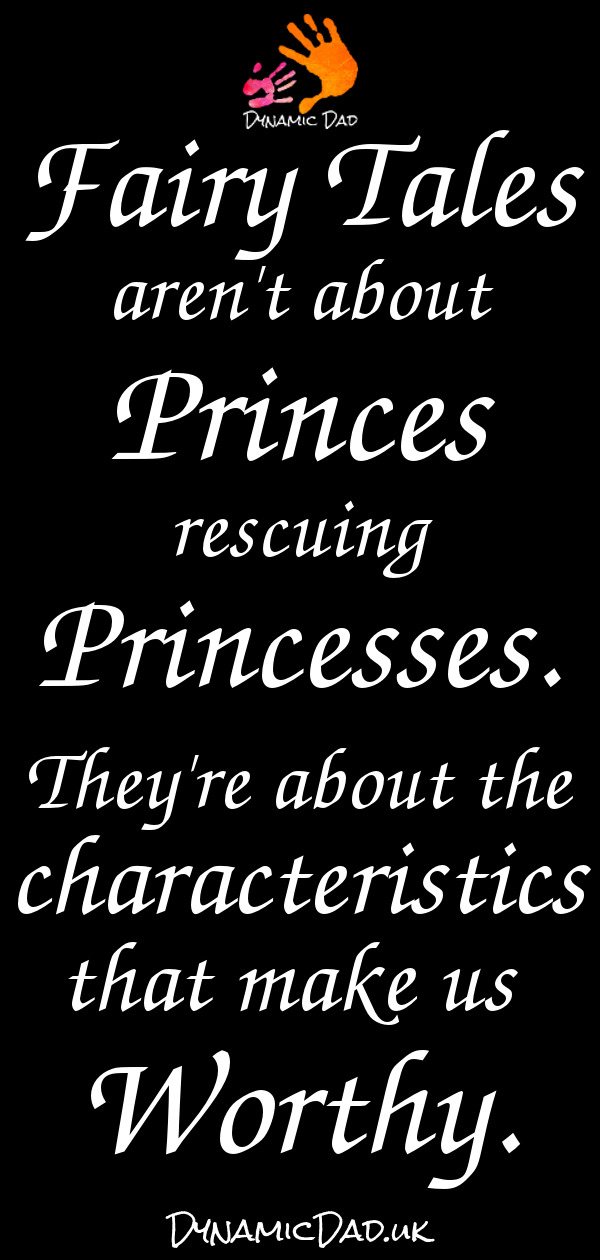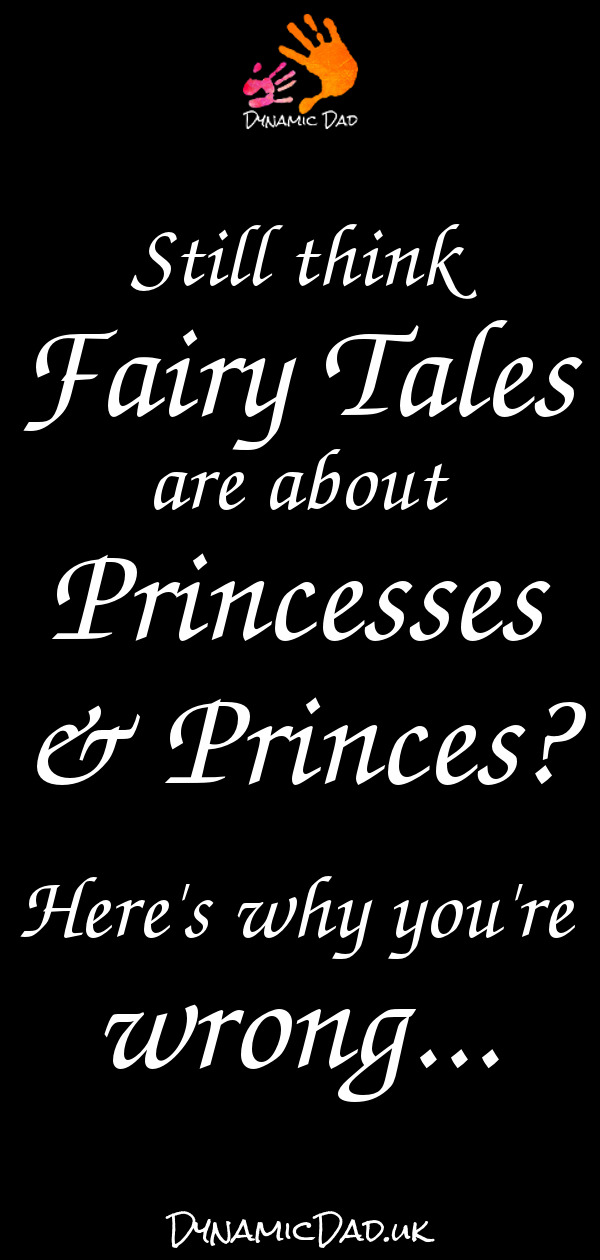Why we SHOULDN’T rewrite fairy tales

Recently I’ve seen more and more statements that fairytales are outdated remnants of archaic patriarchy suggesting princesses need to be rescued by princes. Even one of the banks is using this line as a base for a marketing campaign. Respectfully, you’re all wrong… and this is why:
Language and its use
Einstein is often quoted to have said “If you want your children to be intelligent, read them fairy tales. If you want them to be more intelligent, read them more fairy tales.”
There is a reason for this; imagination, creativity and thinking outside the box is something we need our next generations to do – something I discuss more in “How to raise smarter kids“.
Remember your school days when you were forced to study English Language and English Literature?
Where you had to consider the different meanings that each word could have, and the metaphors presented in literature?
We’ve forgotten how to do this – all we see now is “A princess needs rescuing by a prince”.
This is not the point of any of the fairy tales. Let’s look at a couple from a different perspective – a more positive one we can teach to our children, both our princesses and our princes.
Snow White
A brief and loose summary of Disney’s variation on the Snow White story is that her stepmother, the Queen was jealous of Snow White’s beauty and tried to get rid of her, so the step mother could have all the attention. Snow White went into hiding with seven Dwarves.
The evil stepmother found out, and lured her into taking a bite from a poisoned apple. Snow White fell into an eternal death-like sleep only to be awoken by a kiss from a prince. Meanwhile, the Dwarves chased her step-mother to a cliff where she was struck by lightning and fell to her death.
What I think we should learn from this:
The Queen
First, jealousy gets us nowhere. The huntsman did not kill Snow White because he didn’t agree with the queen’s perspective, and ultimately the queen was struck by lightning and died – all because of her jealousy.
So, don’t allow yourself to become a jealous person – be grateful and supportive of what others have, and you will likely reap the rewards as the other characters did.
The Dwarves
Snow White was supported by no less than seven highly (toxically?) masculine miners – and NONE of them took advantage of her.
These miners were all ‘different’ from the society Snow White had been used to – both in appearance and in personality.
They found life so hard that they had to band together to live, yet still found a way to support her. In return, she did what she could to help them to find balance and equality.
Snow White
Even with their unusual appearance and personalities, Snow White did not sneer at the Dwarves, she embraced them and their company. They supported each other despite their differences.
The Apple
The apple shows us several things: for the less mature audience – don’t accept things from strangers.
For the older children, the dangers of seeking instant gratification instead of putting in the work to pick your own apples, the risks of succumbing to peer pressure and temptation despite gut feeling and better judgement.
It also teaches the value in questioning things that appear to good to be true.
The Prince & the kiss
The prince isn’t really a prince. He is her prince. He is entirely of her own making – she is ‘rescued’ by her choices, not by ‘him’. The kiss represents the things Snow White truly wanted and needed in her life and in her relationships – his character and personality.
These are the things she learned from the Dwarves – she needed a little bit of all of them to make up her one true prince, having learned the positives and negatives of each of their personalities. Had the man who kissed her not possessed these qualities, she would not have woken up.
Teach your children:
To act as the Snow White & the Dwarves did – to help and support each other, to not take advantage of those in need of help.
To pitch in where you can and not to sneer or mock those who are different to you or your experiences in life so far.
To think of the possible consequences of their actions, the dangers of the ‘easy option’ and the benefits of an inquisitive mind.
That we are responsible for our own choices – and that these determine our future. That we choose our prince as well as how to conduct ourselves in order to be that prince.
Cinderella
This fairy tale poses similar lessons, but for a prince seeking his princess. Cinderella is mistreated by her ugly stepsisters and stepmother and is unable to go to the Royal Ball without the help of her fairy godmother (after she wishes she could go to the ball).
Once there, the prince is enchanted with her beauty and dances with her all night until she must leave at midnight. She loses a glass slipper in the rush to get home and the prince searches the kingdom for the woman whom the slipper will fit. He finds Cinderella and promptly marries her.
What we should learn from this:
The stepsisters & stepmother
Again, those who mistreat others do not get what they want – to marry the prince in this story.
Midnight
Life has a time limit. We cannot procrastinate forever, we must make the best of what we have, with a little help from our friends, and make what we want to happen, happen.
The Wish
We must also speak out – if we want something we can’t hold our tongue, otherwise the fairy godmother would never have heard the wish.
The Slipper
The slipper was not a slipper. It was a representation of what the prince was looking for in his life partner and his bride – transparent, hard working, caring, determined, thoughtful, resourceful etc.
Cinderella demonstrated all of these things while working around the house, yet the prince had to search the entire kingdom to find the right woman for him – one who was not of aristocratic lineage or otherwise seen as ‘fit’ for a prince.
Teach your children:
These are the traits that our daughters should seek to master and demonstrate – in their lives and careers.
They are also the qualities our sons should value and look for in their partners.
There is a difference between what we need and is good for us, and what we think we need – or want.
Metaphorical appearances
Fairy tales in general contain a lot of beauty and ugliness. These are not really the physical appearance of the characters, they are their personalities. It is so very important that our children learn this.
We’ve all experienced the ‘hottie’ who turns out to be a vain and horrible person, and we’ve all ignored physical ‘blemishes’ because they are much less important than the beauty within.
Much of this comes with age as superficial desires start to fall away, but we can still teach it from childhood and remind our teens (and ourselves) too.
Happily ever after
Fairytales should not be taken at face value; prince rescues princess, or worse, princess needs rescuing.
There are important lessons to learn about character, feelings and relationships – it’s our job as parents to teach them.
Fairy tales aren’t about princes rescuing princesses, they’re about the characteristics that make us worthy.
My only issues with them are that the step-parents seem to be the evil ones and the birth-parents seem to be ignorant of it. Being the divorced dad in my daughter’s story, I need to ensure this doesn’t happen to her!
Maybe with your help I’ll find the metaphor I’ve missed… comment below!









My favourite was the little Mermaid and I HATE the Disney version. The in the original, she makes all these changes for a guy who doesn’t even notice her and goes off into the sunset with another woman. She loses all her extraordinariness just trying to fit in with some societal views of what’s beauty. Ditto little matchgirl. If she’s not dying at the end, I want no part of it. #Dreamteam
I didn’t know that – and yet another lesson for our kids! Be yourself, don’t try to change for someone else, it’s never worth it.
Such an intriguing breakdown. I hope these fairytales will continue to influence the future generations, they are a great stepping stone for discussions with children.
As do I, and yes – that’s exactly how we should use them!
Very interesting
And you should consider
Red Riding Hood
It isn’t her father that saves her
But the Forrest man
Out chopping Wood
Or Hansel and Gretel
Where the children work it out for themselves
And learn to protect each other
I really enjoyed this. I agree so much with what we can learn and teach when we look at these stories metaphorically, rather than the literal prince and princess stuff. Great read #ThatFridayLinky
All these classic fairytales have been rewritten over the ages. In Cinderella, the step sisters cut off toes to fit in the slipper. Instead of kissing sleeping beauty, the prince impregnated her and she was woken up by the baby biting her.
As to you wider point that the gender dynamics don’t matter, children learn from stories. Dismissing what they learn from these is ding them a disservice.
This has got me thinking about Harry Potter. see I think harry Potter is awesome. A tale of friendship, loyalty, love even while facing a dangerous foe. Some fairy tales are horrible I think. I wouldn’t want my kids t hear them because they are so grim )or should I say Brothers Grimm, boom boom). I find it hard to believe most do any long term damage to our kids.
I am totally with you on this, we and our children can learn from original stories. There’s too much ‘health and safety’ being put in place in the rewritten stories. Meh! #ThatFridayLinky
Excellent points. If somebody thinks that an old tale is outdated, write a new one! We enjoyed the live action Beauty and the Beast, but I think the best tale of the past decade was Zootopia. Fairy tales have been used as morality lessons since the beginning of time and many of the basic lessons are universal, without need of update #thatfridaylinky
100% agree lot can be learned from fairy tales just make we are showing the less gruesome ones to our little ones Thank you for linking to #Thatfridaylinky please come back next week
I’ve never really thought much of the lessons behind fairy tales, but you’ve pointed out great lessons to think about! #DreamTeam
I love this so very much and love hearing a dad’s perspective! Visiting you today from the mix it up linky. laurensparks.net
Ok ok ok…..you got me…I confess I expected to hate this blog post and get all on my high horse as I do find some fairytales really bother me . You’ve actually don’t the opposite and had me nodding along to life lessons we can Learn from the old stories !!! #blogcrush
I’m glad you think so… it’s too easy now to get bogged down in the superficial aspects of anything or opinion – and stay blinkered to other perspectives.
Great post, Dynamic Dad! Just tweeted it for all those who’ve recently read Keira Knightley’s and Kristen Bell’s comments about fairy tales.
Glad to see this back on #blogcrush this week